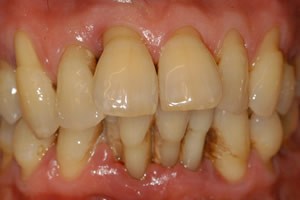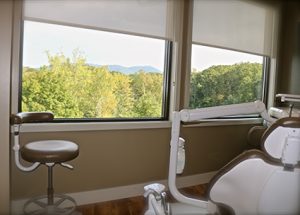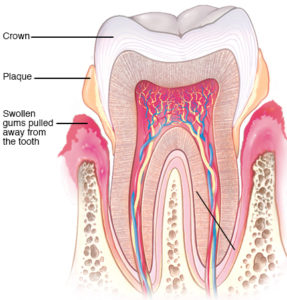Header logo
header top contact widget
Periodontitis
Tissue Regeneration In Dentistry Is Here & Now!
Posted on Jan 31, 2020 by William J. Claiborne, DDS MS
It may sound far-fetched to think of repairing the urethra by regenerating tissues from the mouth. Yet, it’s being done – with the help of advanced technology.
Stricture of the urethra (the duct that carries urine out of the bladder) affects about 1 percent of the male population. For the one percent who suffer with it, urethral stricture contributes to a severely diminished quality of life.
The condition causes patients to be chronically ill, have low urine flow, pain, urinary infections, urinary stones and can lead to failure of the urinary system. Untreated, life-threatening urinary retention can occur.
Recently, a breakthrough in the surgical treatment of male urethral stricture was reported when over 81 percent of patients with urethral strictures were successfully treated with MukoCell.
MukoCell is a method for tissue-engineered oral mucosa transplantation. It takes a small area of oral mucosa (the secreting tissues in the mouth) that is easily accessible in any patient. (https://www.healtheuropa.eu/treatment-of-mens-disease-with-regenerative-medicine/96925/)
In the past, the most successful treatment for urethral reconstruction was through an oral mucosa graft. However this process requires harvesting a large area of oral tissues. The repercussions can leave patients with persistent pain, bleeding, swelling, sensory loss and oral numbness.
Removing large segments of tissues in the mouth can also cause impaired ability to drink, eat and speak. It can lead to periodontal (gum) disease,tooth loss and dental implant failure along with an increased risk of oral cancer.
MukoCell is a method for a tissue-engineered oral mucosa transplant with even better success rates that the standard grafting procedure. Like our LANAP technology, MukoCell can regenerate tissues, although MukoCell regeneration is through a tissue factory that uses a small piece of the patient’s oral mucosa.
In our Asheville Periodontal dental office, tissue regeneration can be successfully performed in the patient’s mouth. Through our LANAP technology (Laser-Assisted New Attachment Procedure) this highly-advanced method efficiently and effectively treats periodontitis (advanced gum disease).
When it comes to oral structure loss, our LANAP technology is able to stimulate bone regrowth in damaged areas. It can regrow periodontal ligament, alveolar bone (the bony ridge that supports the upper teeth), and regrow the bony film that adheres teeth to the jaw.
LANAP includes a minimally invasive (essentially ‘non-surgical’) PerioLase laser that treats patients with moderate to severe periodontal disease – in as little as one session. It is safe for people with conditions such as diabetes, heart disease, and hemophilia.
LANAP’s laser also eliminates the need for cutting into gum tissues with a scalpel. There are no stitches and patients have minimal discomfort following the procedure.
The advanced technology of LANAP offers a simple yet successful way to rid the infectious bacteria of advanced gum disease. By combating this inflammatory disease, the body is at less risk for systemic inflammation that has been shown to contribute to serious and even deadly health problems.
Overcoming gum disease can help patients to save natural teeth. This means the trauma of tooth loss and decisions for replacement can be avoided.
While we applaud astounding developments in tissue regeneration, MukoCell’s progress reinforces the importance of having a healthy ‘oral cavity’. This is why we committed to include the LANAP protocol into our periodontal dental office, making this cutting edge technology accessible to people all across Western North Carolina.
Although people often think of their smile as ‘teeth,’ the tissues in the mouth are a vital part of your smile, your oral health, and your overall health. They are your blanket of protection that shields vulnerable structures beneath from bacterial destruction. When this covering of gum tissues becomes damaged, LANAP offers an efficient and effective method to restore the healthy state of what was lost.
If you suffer with symptoms of gum disease (tender gums that bleed when brushing, persistent bad breath, or gums that have turned red in color), call our office promptly at 828-274-9440. The condition will only worsen without treatment and could result in tooth loss as well as the release of potent bacteria into the bloodstream.
Is Your Insurance Ruining Your Oral Health?
Posted on Nov 26, 2019 by William J. Claiborne, DDS MS
A necessary ‘evil.’
These days, insurance coverage seems to be an ever-expanding chunk out of paychecks. Even so, coverages seem to be getting more and more limited.
Yet, health insurance is an investment that provides peace of mind and reminds us that we need to do all we can to stay healthy – and NOT need it! Deductibles, uncovered items, and prescriptions can drain the wallet in spite of what is shelled out for monthly premiums.
Regardless of the insurance coverage you have, taking full advantage of its benefits is an annual goal. Some people have Health Savings Accounts (HSA) to give some padding for certain expenses not covered by insurances.
Because of out-of-pocket expenses, dental patients sometimes make decisions on accepting treatment based on what their insurance covers. This can be detrimental to the patient.
Dental insurance was developed to give people some help for basic annual expenses. For many, this includes twice-a-year dental exams and cleanings. Some policies include assistance for an annual crown or filling, and some coverage for periodontal (gum) therapy to treat gum disease.
Although adults may see these coverages as ample, they can be far from sufficient some years. For aging adults or people who have conditions such as diabetes or take medications that have an oral dryness side effect, basic insurance coverage can be far from what is in your best interest.
Keep in mind that insurance companies are for-profit businesses. What these companies deem coverage-worthy may be far from what is best for a patient’s long term oral health.
Think about this … As of Aug. 2, 2018, publicly traded health care companies amassed $47 billion in profit. (https://www.axios.com/health-care-industry-on-track-massive-q2-profits-1533226387-dacec8f8-c9f5-406c-a49e-1103e3316c64.html) That’s BILLION.
Sadly, insurance companies tend to serve as judge and jury for some people when it comes to treatment decisions. If an insurance company overrules what a dentist or dental specialist advises, it can leave the patient with an even more-complex situation.
They also use additional limiting terms such as “usual and customary.” This means that it is the insurance company that determines what is reimbursed for the treatment rather than the skill level and reputation of the provider.
Another dilemma for today’s insured patient has to do with the treatment recommended. For instance, when I consult with a patient who is missing teeth, I typically advise dental implants. My recommendation is based upon what will provide the patient with a lifelong solution for missing teeth as well as other benefits.
I look at a dental implant as the ideal in tooth replacement, since it is held in the jaw bone just as natural tooth roots. An implant restores the dependable foundation necessary for biting and chewing, enabling the patient to eat a healthy diet and chew foods comfortably, which supports the digestive system and overall health.
Dental implants are a more expensive option (initially) than crown-&-bridge combinations, dentures, or partials. They are designed to last a lifetime; often far beyond the span of time an average policy holder would stick with the insuring company.
As beneficial as they are to your overall health, dental implants are often deemed as ‘elective’ by insurance companies. This is where the patient must decide: “Is protecting my overall health and smiling confidence a priority to me or should I go with what my insurance coverage allows?”
What it comes down to is, essentially, how we perceive insurance coverage. While major medical insurance gives us peace of mind should we experience a health challenge that would otherwise drain us financially, dental insurance coverages are different.
Dental insurance, for the most part with most policies, is structured as a ‘support’ for helping those covered to maintain a healthy mouth. For people who already have good oral health and are able to tend to it sufficiently between checkups, this is fine. However, for most American adults, tooth repair, tooth loss and gum problems are a fact of life, particularly as we age.
For most of us, the decisions we make today will affect us in the years to come. When it comes to your oral health, don’t let your long-term oral wellness, the longevity of your teeth, the comfort of healthy eating, or the confidence of smiling and laughter be dictated by what insurance coverage allows.
When it comes to your smile, put your needs first.
If you trust your dentist and others involved to guide you towards good oral health and maintaining your smile, consider their recommendations and ask questions. Be an informed consumer. But, most importantly, make decisions that are in your best interest rather than that a for-profit insurance company deems is worthy for your smile.
If you don’t have regular dental care and would like recommendations, feel free to contact us at 828-274-9440. We work with exceptional general dentists in Western North Carolina and will be proud to connect you. Or, feel free to begin with a thorough periodontal exam here. We will make recommendations based upon your unique needs and goals.
Rheumatoid Arthritis (RA) Linked To Periodontal Disease
Posted on Oct 02, 2019 by William J. Claiborne, DDS MS
 As a periodontist, I specialize in the treatment of all stages of periodontal (gum) disease. Although this particular dental specialty is not as visible as a general dentist, we are very-involved members of the medical and dental community. According to the Centers for Disease Control & Prevention (CDC), over 47 percent of American adults have some level of gum disease.
As a periodontist, I specialize in the treatment of all stages of periodontal (gum) disease. Although this particular dental specialty is not as visible as a general dentist, we are very-involved members of the medical and dental community. According to the Centers for Disease Control & Prevention (CDC), over 47 percent of American adults have some level of gum disease.
Like the formation of cancer, many individuals are unaware when periodontal disease becomes active. When early symptoms appear (such as bleeding gums when brushing, bad breath and gum tenderness), many people shrug them off as temporary.
However, gum disease only progresses once underway. Eventually, gums become red in color and pus pockets form at the base of teeth. In advanced stages, teeth loosen and may require removal. Gum disease, to no surprise, is the nation’s leading cause of adult tooth loss.
The potent bacteria of periodontal disease can enter the bloodstream through tears in weakened gum tissues. This allows it to travel throughout the body. Research has shown it is able to trigger a number of serious health problems, including heart disease, stroke, diabetes, memory loss, and impotency.
Rheumatoid arthritis (RA), a condition seemingly unrelated to gum disease, is a debilitating disease that destroys joints. It is disabling and painful. In most cases, RA emerges gradually, often beginning with morning stiffness along with weak and aching muscles. Joint pain follows, with joints feeling sore and stiff. RA is typically found in the fingers, wrists, elbows, hips, knees, ankles, toes, shoulder and neck.
As inflammation from RA increases, joints become swollen with symptoms including fever, disfiguring of hands and feet, numbness and tingling. There is no cure for RA and lifelong treatment is required. Treatment may consist of medications, physical therapy, or even surgery.
Yet, like RA, gum disease causes pain, swelling, and tenderness. As it worsens, the associated inflammation can lead to destruction of the bone that supports teeth along with surrounding tissues. And, the similarities go much deeper.
Both gum disease and RA share a genetic likeness in clinical makeup and structures. This has been particularly apparent in pathogens, which are agents in the body that lead to disease or illness. The pathological processes that occurs in both gum disease and RA are almost identical.
Too, the particular species of bacteria found in gum-diseased oral tissues and tissues that surround joints in those who suffer with RA. Equally concerning is, while both conditions clearly cause chronic inflammation in tissues connected to bone, researchers have found the two diseases share a similar inflammatory trigger.
In one study, a particular pathogen associated with periodontal disease was found to activate the same destructive process of rheumatoid arthritis. It has also been shown that, by treating periodontal disease in RA patients, RA symptoms often improve ( likely due to the system’s reduced burden of oral inflammation).
These findings reveal just how closely our oral health correlates

A relaxing and comfy environment.
to our overall health. This information should send up alarms that the presence of gum disease can greatly increase your risk for serious health conditions. Clearly, people who have RA should be particularly diligent when it comes to their oral health.
If you are experiencing symptoms of gum disease (as mentioned above), seek treatment at your earliest convenience. You can begin with a consultation appointment in our comfortable Asheville periodontal office. A referral is not needed.
Call 828-274-9440 to learn more.
Protect Your Heart. Start With Your Smile!
Posted on Jul 17, 2019 by William J. Claiborne, DDS MS
According to a report on the health of Americans (published by the Centers for Disease Control & Prevention, or ‘CDC’), it is estimated that over 47 percent have some form of gum disease. Although we all aspire to have a smile that is appealing, it is what lies beneath the teeth and gums that can reek havoc on one’s overall health.

Signs of gum disease
Over time, inadequate daily oral hygiene enables an overload of bacteria in the mouth. For people who have habits such as smoking, unhealthy diets, and alcohol consumption, their vulnerability is even more susceptible to this bacterial buildup.
This is also true for people as they age. Aging contributes to a reduced ability to produce saliva, the mouth’s oral rinsing agent. When saliva flow fails to ‘wash away’ bacteria at sufficient levels, the accumulation runs rampant.
Oral bacteria are living, eating, and reproducing organisms. They thrive on rotting food particles caught between teeth. They attack gum tissues and tooth enamel. Eventually, they can work their way down tooth roots and attack the bones and tendons that support teeth.
What’s even scarier is the fact that these infectious critters can enter the bloodstream. This potent bacteria are now associated with a number of serious health conditions due to their ability to trigger systemic inflammation.
When the gum tissues can no longer combat the onslaught of bacteria, there can be very few signs of periodontal (gum) disease initially. Signs that emerge are typically frequent bad breath along with swollen, tender and beefy red gums that bleed when you brush. As they grow in number, the gum tissues become weaker and they can penetrate the bloodstream.
According to the American Academy of Periodontology (www.perio.org),
“Several studies have shown that periodontal disease is associated with heart disease. While a cause-and-effect relationship has not yet been proven, research has indicated that periodontal disease increases the risk of heart disease.
“Scientists believe that inflammation caused by periodontal disease may be responsible for the association.
“Periodontal disease can also exacerbate existing heart conditions. Patients at risk for infective endocarditis may require antibiotics prior to dental procedures. Your periodontist and cardiologist will be able to determine if your heart condition requires use of antibiotics prior to dental procedures.”
For this reason, cardiologists are more often advising their patients to be evaluated by a periodontist prior to heart surgery. As mentioned above, gums that bleed are a sign of gum disease. These oral bacteria, given an opportunity to enter the bloodstream, are able to travel anywhere, including the heart. They can reach the heart muscle and cause a severe infection.
For decades, researchers have probed the link between gum disease and cardiovascular health. People with gum disease (also known as periodontal disease) have two to three times the risk of having a heart attack, stroke or other serious cardiovascular event.
Acting as a contributing factor to heart disease is highly serious. Yet, the risks associated with gum disease don’t stop there. Research has shown this potent oral bacteria can set a path of destruction into motion. It has been linked to some cancers, stroke, diabetes, arthritis, preterm babies, impotency, and even Alzheimer’s.
Twice-daily brushing and daily flossing takes mere minutes and is inexpensive to do. Seeing a dentist every 6 months for oral exams and cleanings saves an individual far more by preventing problems than they cost. Yet, too many adults fail to devote the investment to this necessary part of a healthy lifestyle.
An estimated 65 percent of adults ages 18 – 64 see a dentist only once a year. Approximately 55 percent of adults brush their teeth twice a day, which is too little. (https://www.reference.com/health/many-times-day-people-brush-teeth-34d1104798029b7a) I believe it would be jolting to most adults to view dental floss under a microscope after their teeth have been flossed.
As an Asheville periodontal specialist, I have an up-close view of the damaging affects of insufficient oral hygiene. It often results in tooth loss, which is not a natural part of the aging process, as some people believe. Having your natural teeth for a lifetime is more than achievable and has even been shown to add to one’s lifespan (by up to ten years).
If you’ve failed to be fully committed to your oral health, there is no better time to begin than the present. Start with a thorough periodontal examination. Call 828-274-9440.
If dental fears have prevented you from having regular dental care, consider beginning with a consultation. This occurs in a comfortable, private consultation room that is removed from the clinical side of the office. This will be a friendly, informative conversation and you will not be asked to sit in a treatment chair during this visit.
Let’s protect you, top to bottom, beginning with your smile!
Recent Posts
Categories
Archives
- September 2024
- August 2024
- July 2024
- June 2024
- May 2024
- April 2024
- March 2024
- February 2024
- January 2024
- December 2023
- November 2023
- October 2023
- September 2023
- August 2023
- July 2023
- June 2023
- May 2023
- April 2023
- March 2023
- February 2023
- January 2023
- December 2022
- November 2022
- October 2022
- September 2022
- August 2022
- July 2022
- June 2022
- May 2022
- April 2022
- March 2022
- February 2022
- January 2022
- December 2021
- November 2021
- October 2021
- September 2021
- August 2021
- July 2021
- June 2021
- May 2021
- April 2021
- March 2021
- February 2021
- January 2021
- December 2020
- November 2020
- October 2020
- September 2020
- August 2020
- July 2020
- June 2020
- May 2020
- April 2020
- March 2020
- February 2020
- January 2020
- December 2019
- November 2019
- October 2019
- September 2019
- August 2019
- July 2019
- June 2019
- May 2019
- April 2019
- March 2019
- February 2019
- January 2019
- December 2018
- November 2018
- October 2018
- September 2018
- August 2018
- July 2018
- June 2018
- May 2018
- April 2018
- March 2018
- February 2018
- January 2018
- December 2017
- November 2017
- October 2017
- September 2017
- August 2017
- July 2017
- June 2017
- May 2017
- April 2017
- March 2017
- February 2017
- January 2017
- December 2016
- November 2016
- October 2016
- September 2016
- August 2016
- July 2016
- June 2016
- May 2016
- April 2016
- March 2016
- February 2016
- January 2016
- December 2015
- November 2015
- October 2015
- September 2015
- August 2015
- July 2015
- June 2015
- May 2015
- April 2015
- March 2015
- February 2015
- January 2015
- December 2014
- November 2014
- October 2014
- September 2014
- August 2014
- July 2014
- June 2014
- May 2014
- April 2014
- March 2014
- February 2014
- January 2014
- December 2013
- November 2013
- October 2013
- September 2013
- August 2013
- July 2013
- June 2013
- May 2013
- April 2013
- March 2013
- February 2013
- January 2013
- December 2012
- November 2012
- October 2012
- September 2012
- August 2012
- July 2012
- June 2012


